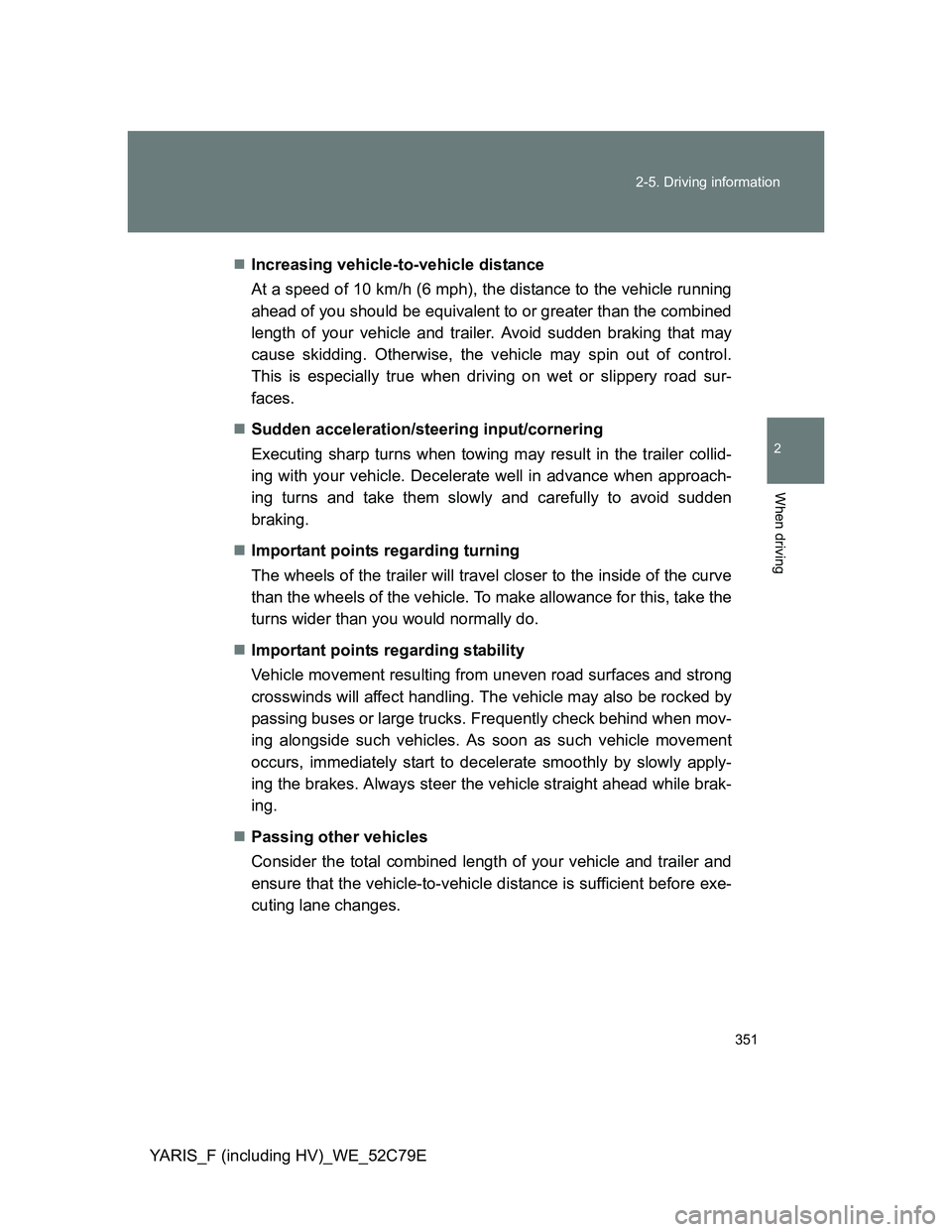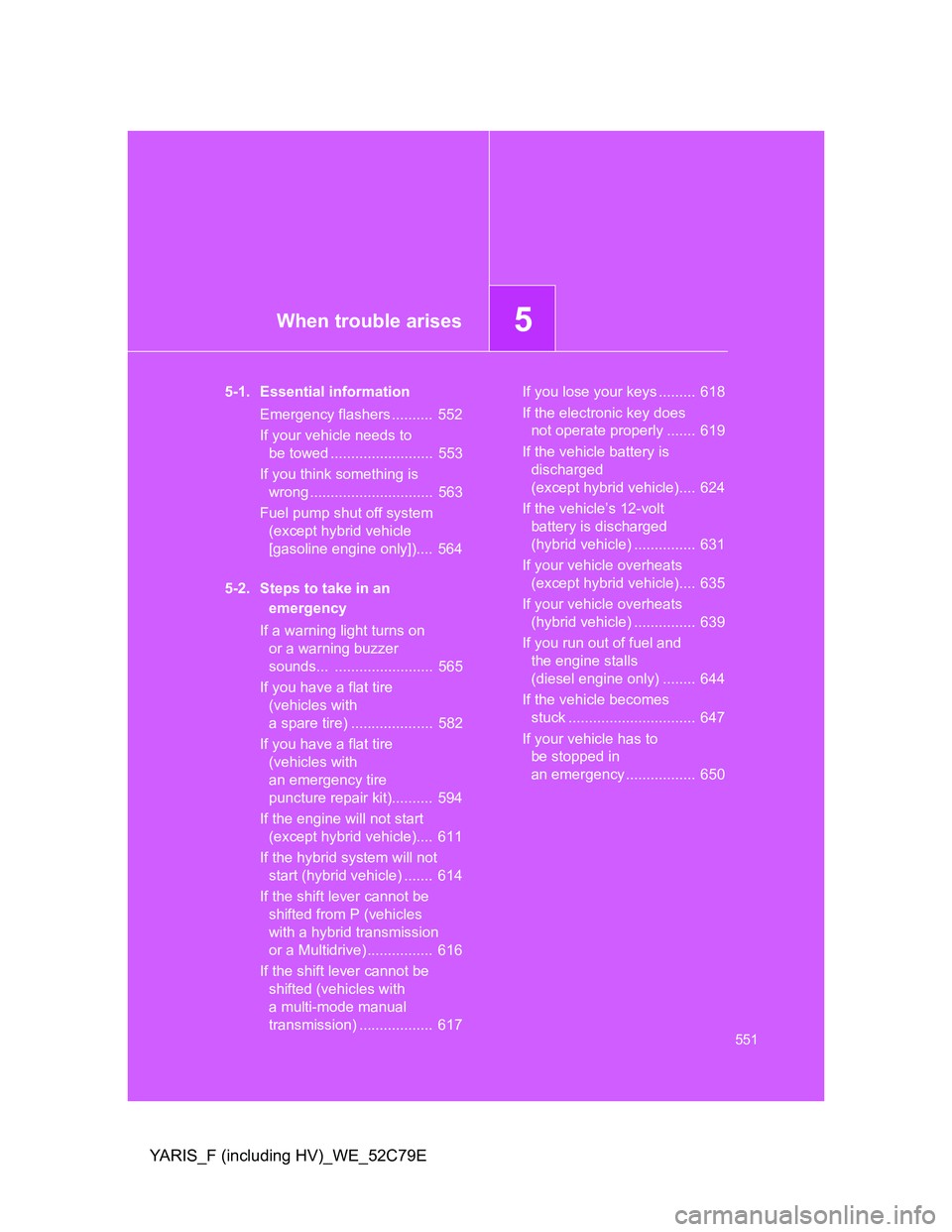Page 351 of 704

351 2-5. Driving information
2
When driving
YARIS_F (including HV)_WE_52C79EIncreasing vehicle-to-vehicle distance
At a speed of 10 km/h (6 mph), the distance to the vehicle running
ahead of you should be equivalent to or greater than the combined
length of your vehicle and trailer. Avoid sudden braking that may
cause skidding. Otherwise, the vehicle may spin out of control.
This is especially true when driving on wet or slippery road sur-
faces.
Sudden acceleration/steering input/cornering
Executing sharp turns when towing may result in the trailer collid-
ing with your vehicle. Decelerate well in advance when approach-
ing turns and take them slowly and carefully to avoid sudden
braking.
Important points regarding turning
The wheels of the trailer will travel closer to the inside of the curve
than the wheels of the vehicle. To make allowance for this, take the
turns wider than you would normally do.
Important points regarding stability
Vehicle movement resulting from uneven road surfaces and strong
crosswinds will affect handling. The vehicle may also be rocked by
passing buses or large trucks. Frequently check behind when mov-
ing alongside such vehicles. As soon as such vehicle movement
occurs, immediately start to decelerate smoothly by slowly apply-
ing the brakes. Always steer the vehicle straight ahead while brak-
ing.
Passing other vehicles
Consider the total combined length of your vehicle and trailer and
ensure that the vehicle-to-vehicle distance is sufficient before exe-
cuting lane changes.
Page 352 of 704

352 2-5. Driving information
YARIS_F (including HV)_WE_52C79ETransmission information
Vehicles with a Multidrive and multi-mode manual transmission:
To maintain engine braking efficiency, when using engine braking,
do not use the transmission in D. Transmission shift gear position
must be in 4 in the M mode. (P. 255, 260)
Vehicles with a manual transmission:
To maintain engine braking efficiency, when using engine braking,
do not use the transmission in 5 and 6 (vehicles with a 6-speed
manual transmission) gear. (P. 265)
If the engine overheats
Towing a loaded trailer up a long, steep incline in temperatures
exceeding 30C (85F) may result in the engine overheating. If the
high engine coolant temperature warning light flashes or comes
on, turn the air conditioning off immediately, leave the road and
stop the vehicle in a safe place. (P. 635)
When parking the vehicle
Always place wheel chocks under the wheels of both the vehicle
and trailer. Firmly set the parking brake and shift the shift lever to P
for Multidrives, E, M or R for multi-mode manual transmissions,
and 1 or R for manual transmissions.
Page 353 of 704
353 2-5. Driving information
2
When driving
YARIS_F (including HV)_WE_52C79E
CAUTION
Follow all the instructions described in this section. Failure to do so could
cause an accident resulting in death or serious injury.
Trailer towing precautions
When towing, make sure that none of the weight limits are exceeded.
(P. 344)
Vehicle speed in towing
Observe the legal maximum speeds for trailer towing.
Before descending hills or long declines
Reduce speed and downshift. However, never downshift suddenly while
descending steep or long downhill grades.
Operation of the brake pedal
Do not hold the brake pedal depressed often or for long periods of time.
Doing so may result in the brake overheating or reduce braking effects.
To avoid accident or injury
Do not use cruise control when you are towing.
Vehicles with a compact spare tire: Do not tow the vehicle with the com-
pact spare tire installed.
Page 424 of 704
424 3-4. Using the storage features
YARIS_F (including HV)_WE_52C79E
CAUTION
Items unsuitable for the bottle holder
Do not place anything other than a bottle in the bottle holders.
Other items may be thrown out of the holders in the event of an accident or
sudden braking and cause injury.
NOTICE
Items that should not be stowed in the bottle holders
Put the cap on before stowing a bottle. Do not place open bottles in the bot-
tle holders, or glasses and paper cups containing liquid. The contents may
spill and glasses may break.
Bottle holders
Page 442 of 704
442 3-5. Other interior features
YARIS_F (including HV)_WE_52C79E
Removing the deck board
Lift the deck board and pull it
toward you to remove it.
Securing the deck board
Lift the deck board up.
Remove the hook on the back-
side of the deck board.
Attach the hook to the upper
edge of the back door opening
as shown.
Page 458 of 704
458 4-3. Do-it-yourself maintenance
YARIS_F (including HV)_WE_52C79E
ItemsParts and tools
Engine oil levelP. 471)• “Toyota Genuine Motor Oil” or
equivalent
• Rag or paper towel
• Funnel (used only for adding
engine oil)
Fuses (P. 510)• Fuse with same amperage rating
as original
Light bulbs (P. 535)• Bulb with same number and watt-
age rating as original
• Phillips-head screwdriver
• Flathead screwdriver
• Wrench
Radiator, condenser and inter-
cooler (P. 481)
Tire inflation pressure (P. 498)• Tire pressure gauge
• Compressed air source
Washer fluid (P. 485)• Water or washer fluid containing
antifreeze (for winter use)
• Funnel (used only for adding
water or washer fluid)
Page 496 of 704
496 4-3. Do-it-yourself maintenance
YARIS_F (including HV)_WE_52C79E
CAUTION
When inspecting or replacing tires
Observe the following precautions to prevent accidents.
Failure to do so may cause damage to parts of the drive train as well as dan-
gerous handling characteristics, which may lead to an accident resulting in
death or serious injury.
Do not mix tires of different makes, models or tread patterns.
Also, do not mix tires of remarkably different treadwear.
Do not use tire sizes other than those recommended by Toyota.
Do not mix differently constructed tires (radial, bias-belted or bias-ply
tires).
Do not mix summer, all season and snow tires.
Do not use tires that have been used on another vehicle.
Do not use tires if you do not know how they were used previously.
Vehicles with a compact spare tire: Do not tow if your vehicle has a com-
pact spare tire installed.
Page 551 of 704

5When trouble arises
551
YARIS_F (including HV)_WE_52C79E
5-1. Essential information
Emergency flashers .......... 552
If your vehicle needs to
be towed ......................... 553
If you think something is
wrong .............................. 563
Fuel pump shut off system
(except hybrid vehicle
[gasoline engine only]).... 564
5-2. Steps to take in an
emergency
If a warning light turns on
or a warning buzzer
sounds... ........................ 565
If you have a flat tire
(vehicles with
a spare tire) .................... 582
If you have a flat tire
(vehicles with
an emergency tire
puncture repair kit).......... 594
If the engine will not start
(except hybrid vehicle).... 611
If the hybrid system will not
start (hybrid vehicle) ....... 614
If the shift lever cannot be
shifted from P (vehicles
with a hybrid transmission
or a Multidrive) ................ 616
If the shift lever cannot be
shifted (vehicles with
a multi-mode manual
transmission) .................. 617If you lose your keys ......... 618
If the electronic key does
not operate properly ....... 619
If the vehicle battery is
discharged
(except hybrid vehicle).... 624
If the vehicle’s 12-volt
battery is discharged
(hybrid vehicle) ............... 631
If your vehicle overheats
(except hybrid vehicle).... 635
If your vehicle overheats
(hybrid vehicle) ............... 639
If you run out of fuel and
the engine stalls
(diesel engine only) ........ 644
If the vehicle becomes
stuck ............................... 647
If your vehicle has to
be stopped in
an emergency ................. 650